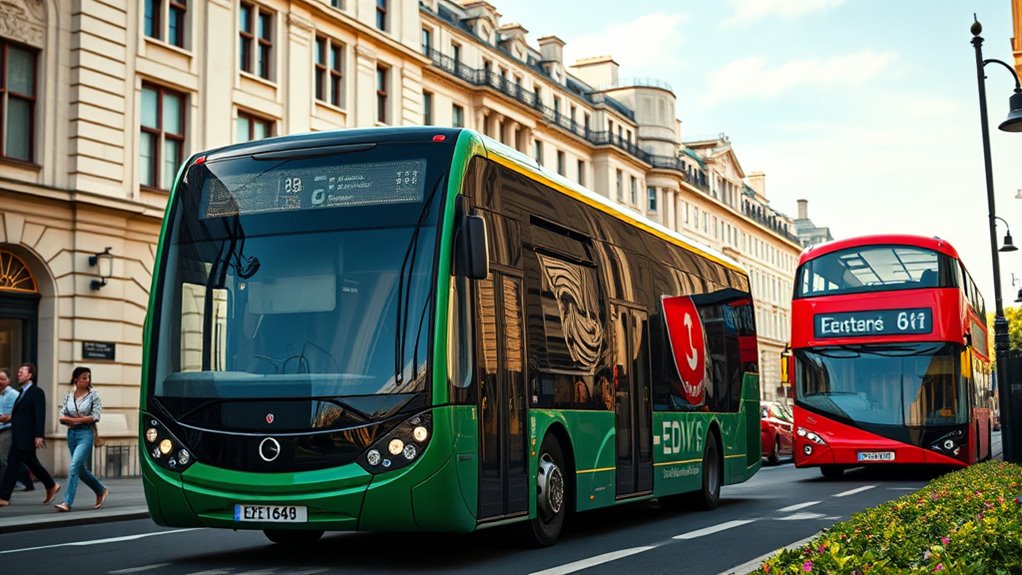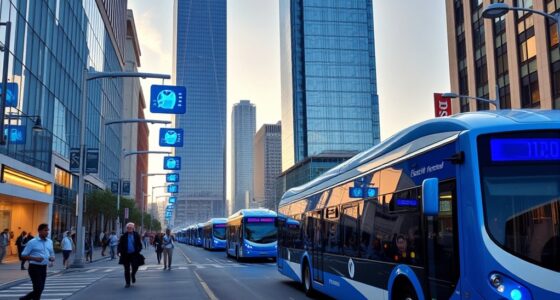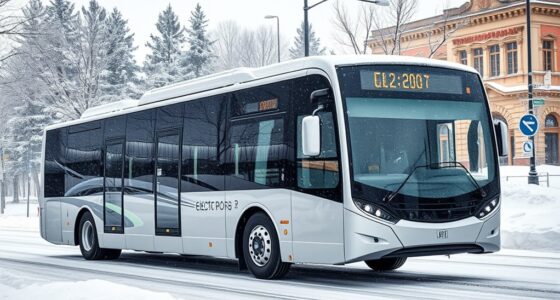London’s switch to electric buses has cut transportation emissions by half by replacing traditional diesel models with over 1,700 zero-emission buses. This shift eliminates tailpipe pollutants and markedly improves air quality across the city. Strategic investments in charging infrastructure and commitments to fully electrify the fleet by 2034 have accelerated these benefits. If you want to understand how these efforts are transforming London’s environment, there’s more to discover about their sustainable transit plans.
Key Takeaways
- Transitioned over 1,600 buses to zero-emission models, significantly cutting tailpipe pollutants.
- Complete fleet electrification by 2034 aims to eliminate nearly 4.8 million tonnes of carbon emissions.
- Replaced traditional diesel buses on major routes, reducing urban air pollutants like NOx and particulates.
- Implemented rapid charging infrastructure, ensuring operational efficiency and minimizing emissions from maintenance.
- Contributes to London’s goal of halving transportation emissions, achieving about 50% reduction in overall fleet-related emissions.

London is making notable strides toward sustainable transportation by expanding its electric bus fleet. With over 1,600 zero-emission buses operating out of a fleet of 9,000, the city is well on its way to transforming its public transit system. By 2023, more than 1,700 electric buses were in service, including models like the Alexander Dennis Enviro400EV, which runs on routes such as Route 63.
London advances sustainable transit with over 1,700 electric buses, including models like the Enviro400EV on Route 63.
This rapid expansion is part of London’s broader plan to become a net-zero carbon city by 2030. The shift to electric buses directly reduces emissions, helping to combat climate change and improve air quality across the city. As these buses replace traditional diesel models, they eliminate tailpipe pollutants, which are a major source of urban air pollution.
The complete electrification of key routes like Route 63, which was fully converted in 2021, has been instrumental in cutting London’s transportation-related emissions. The impact is substantial: converting the entire bus fleet to zero emissions by 2034 could save approximately 4.8 million tonnes of carbon, and if achieved sooner, by 2030, the savings could rise to 5.5 million tonnes. These numbers highlight how aggressive electrification efforts can substantially lower the city’s carbon footprint.
The electric buses also help address local air pollution issues, reducing harmful particulates and nitrogen oxides, which are linked to respiratory illnesses and other health problems. Cleaner buses mean healthier air for London’s residents and visitors alike.
London’s commitment to technological innovation supports these environmental goals. Advanced charging technologies, such as pantograph systems, enable rapid recharging—sometimes in as little as six minutes—on routes like the 358. This efficiency minimizes downtime and ensures reliable service. Charging technologies are essential for maintaining the operational efficiency of electric fleets.
Collaborations with companies like Siemens and Irizar facilitate infrastructure development and help integrate electric buses into existing depots and power grids. The city’s policies require all new buses to be zero emission from 2021, with a target of 100% electric fleet by 2034. These initiatives are backed by strategic partnerships and investments, which make the transition more feasible and cost-effective.
The electrification of major routes demonstrates London’s dedication to sustainable transit solutions. Route 63 and others serve as models for future conversions, showing how electric buses can effectively reduce emissions while maintaining service quality. Sustainable transit solutions are critical for meeting urban environmental targets.
These efforts aren’t just about environmental benefits—they’re also about societal gains, including better air quality, healthier communities, and a more sustainable urban environment. As more electric buses hit the streets, London moves closer to its ambitious goal of halving transportation emissions, creating a cleaner, greener city for everyone. Additionally, adopting electric vehicle infrastructure can further enhance the efficiency and reach of the electric fleet, supporting ongoing sustainability initiatives.
Frequently Asked Questions
What Is the Average Lifespan of London’s Electric Buses?
You’re wondering about the lifespan of London’s electric buses. Currently, they typically last around 14 to 15 years, similar to diesel buses.
London’s transit plans aim to replace diesel buses by 2034, with electric models expected to maintain their lifespan despite newer technology.
As you follow the progression, know that the long-term viability of electric buses looks promising, ensuring they stay efficient and reliable for years to come.
How Does the Cost of Electric Buses Compare to Diesel Buses?
They say “you get what you pay for,” but with electric buses, you might pay more upfront—around double the cost of diesel buses.
However, you save in the long run through lower fuel and maintenance costs, often totaling hundreds of thousands over their lifespan.
Incentives and lower energy prices help offset the initial investment, making electric buses more economical over time despite the higher purchase price.
Are There Plans to Expand the Electric Bus Fleet Further?
You’re interested in whether London’s electric bus fleet will grow further. The city plans to expand considerably, aiming to replace around 1,000 buses annually to reach a zero-emission fleet by 2030.
They’re investing in charging infrastructure and exploring options like hydrogen buses for longer routes. However, funding and grid upgrades are essential.
With these efforts, you can expect the electric fleet to grow, helping London meet its environmental goals.
What Infrastructure Was Needed to Support the Electric Buses?
You need robust infrastructure to support electric buses. This includes installing high-capacity charging points at depots, upgrading power supplies, and establishing reliable grid connections.
Efficient charging systems reduce downtime, while real-time monitoring helps optimize energy use.
Maintenance facilities with trained staff and partnerships with manufacturers ensure smooth operation.
This infrastructure not only keeps the buses running smoothly but also enables London to cut emissions and improve air quality effectively.
How Have Maintenance Costs Changed Since Switching to Electric Buses?
Maintenance costs have markedly diminished since you switched to electric buses. With fewer moving parts and minimal engine components to monitor, you notice a noticeable drop—often nearly halving expenses.
This means less downtime and more dependable service. As you streamline service schedules, your savings grow, and your fleet becomes more efficient.
The shift to electric guarantees you spend less on repairs, while your buses stay on the road longer, maximizing productivity.
Conclusion
Just like Icarus soared toward the sun, London’s electric buses aim for a cleaner future without the risk of burning out. By switching to electric, you’ve taken a bold step, reducing emissions by half and setting a precedent for others to follow. Your journey mirrors the myth’s message: innovation and courage can elevate us beyond old limits. Keep pushing forward; your actions today are shaping a greener, brighter tomorrow.









